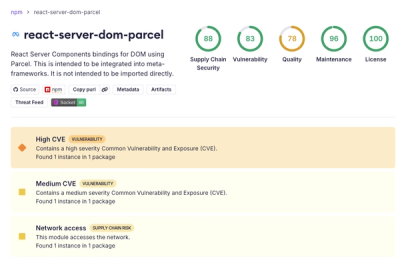
Security News
Deno 2.6 + Socket: Supply Chain Defense In Your CLI
Deno 2.6 introduces deno audit with a new --socket flag that plugs directly into Socket to bring supply chain security checks into the Deno CLI.
react-responsive
Advanced tools


| Package | react-responsive |
| Description | Media queries in react for responsive design |
| Browser Version | >= IE6* |
| Demo |
The best supported, easiest to use react media query module.
$ npm install react-responsive --save
Hooks is a new feature available in 8.0.0!
import React from 'react'
import { useMediaQuery } from 'react-responsive'
const Example = () => {
const isDesktopOrLaptop = useMediaQuery({
query: '(min-width: 1224px)'
})
const isBigScreen = useMediaQuery({ query: '(min-width: 1824px)' })
const isTabletOrMobile = useMediaQuery({ query: '(max-width: 1224px)' })
const isPortrait = useMediaQuery({ query: '(orientation: portrait)' })
const isRetina = useMediaQuery({ query: '(min-resolution: 2dppx)' })
return (
<div>
<h1>Device Test!</h1>
{isDesktopOrLaptop && <p>You are a desktop or laptop</p>}
{isBigScreen && <p>You have a huge screen</p>}
{isTabletOrMobile && <p>You are a tablet or mobile phone</p>}
<p>Your are in {isPortrait ? 'portrait' : 'landscape'} orientation</p>
{isRetina && <p>You are retina</p>}
</div>
)
}
import MediaQuery from 'react-responsive'
const Example = () => (
<div>
<h1>Device Test!</h1>
<MediaQuery minWidth={1224}>
<p>You are a desktop or laptop</p>
<MediaQuery minWidth={1824}>
<p>You also have a huge screen</p>
</MediaQuery>
</MediaQuery>
<MediaQuery minResolution="2dppx">
{/* You can also use a function (render prop) as a child */}
{(matches) =>
matches ? <p>You are retina</p> : <p>You are not retina</p>
}
</MediaQuery>
</div>
)
To make things more idiomatic to react, you can use camel-cased shorthands to construct media queries.
For a list of all possible shorthands and value types see https://github.com/yocontra/react-responsive/blob/master/src/mediaQuery.ts#L9.
Any numbers given as shorthand will be expanded to px (1234 will become '1234px').
The CSS media queries in the example above could be constructed like this:
import React from 'react'
import { useMediaQuery } from 'react-responsive'
const Example = () => {
const isDesktopOrLaptop = useMediaQuery({ minWidth: 1224 })
const isBigScreen = useMediaQuery({ minWidth: 1824 })
const isTabletOrMobile = useMediaQuery({ maxWidth: 1224 })
const isPortrait = useMediaQuery({ orientation: 'portrait' })
const isRetina = useMediaQuery({ minResolution: '2dppx' })
return <div>...</div>
}
device propAt times you may need to render components with different device settings than what gets automatically detected. This is especially useful in a Node environment where these settings can't be detected (SSR) or for testing.
orientation, scan, aspectRatio, deviceAspectRatio,
height, deviceHeight, width, deviceWidth, color, colorIndex, monochrome,
resolution and type
type can be one of: all, grid, aural, braille, handheld, print, projection,
screen, tty, tv or embossed
Note: The device property always applies, even when it can be detected (where window.matchMedia exists).
import { useMediaQuery } from 'react-responsive'
const Example = () => {
const isDesktopOrLaptop = useMediaQuery(
{ minDeviceWidth: 1224 },
{ deviceWidth: 1600 } // `device` prop
)
return (
<div>
{isDesktopOrLaptop && (
<p>
this will always get rendered even if device is shorter than 1224px,
that's because we overrode device settings with 'deviceWidth: 1600'.
</p>
)}
</div>
)
}
You can also pass device to every useMediaQuery hook in the components tree through a React Context.
This should ease up server-side-rendering and testing in a Node environment, e.g:
import { Context as ResponsiveContext } from 'react-responsive'
import { renderToString } from 'react-dom/server'
import App from './App'
...
// Context is just a regular React Context component, it accepts a `value` prop to be passed to consuming components
const mobileApp = renderToString(
<ResponsiveContext.Provider value={{ width: 500 }}>
<App />
</ResponsiveContext.Provider>
)
...
If you use next.js, structure your import like this to disable server-side rendering for components that use this library:
import dynamic from 'next/dynamic'
const MediaQuery = dynamic(() => import('react-responsive'), {
ssr: false
})
import { Context as ResponsiveContext } from 'react-responsive'
import { render } from '@testing-library/react'
import ProductsListing from './ProductsListing'
describe('ProductsListing', () => {
test('matches the snapshot', () => {
const { container: mobile } = render(
<ResponsiveContext.Provider value={{ width: 300 }}>
<ProductsListing />
</ResponsiveContext.Provider>
)
expect(mobile).toMatchSnapshot()
const { container: desktop } = render(
<ResponsiveContext.Provider value={{ width: 1000 }}>
<ProductsListing />
</ResponsiveContext.Provider>
)
expect(desktop).toMatchSnapshot()
})
})
Note that if anything has a device prop passed in it will take precedence over the one from context.
onChangeYou can use the onChange callback to specify a change handler that will be called when the media query's value changes.
import React from 'react'
import { useMediaQuery } from 'react-responsive'
const Example = () => {
const handleMediaQueryChange = (matches) => {
// matches will be true or false based on the value for the media query
}
const isDesktopOrLaptop = useMediaQuery(
{ minWidth: 1224 },
undefined,
handleMediaQueryChange
)
return <div>...</div>
}
import React from 'react'
import MediaQuery from 'react-responsive'
const Example = () => {
const handleMediaQueryChange = (matches) => {
// matches will be true or false based on the value for the media query
}
return (
<MediaQuery minWidth={1224} onChange={handleMediaQueryChange}>
...
</MediaQuery>
)
}
That's it! Now you can create your application specific breakpoints and reuse them easily. Here is an example:
import { useMediaQuery } from 'react-responsive'
const Desktop = ({ children }) => {
const isDesktop = useMediaQuery({ minWidth: 992 })
return isDesktop ? children : null
}
const Tablet = ({ children }) => {
const isTablet = useMediaQuery({ minWidth: 768, maxWidth: 991 })
return isTablet ? children : null
}
const Mobile = ({ children }) => {
const isMobile = useMediaQuery({ maxWidth: 767 })
return isMobile ? children : null
}
const Default = ({ children }) => {
const isNotMobile = useMediaQuery({ minWidth: 768 })
return isNotMobile ? children : null
}
const Example = () => (
<div>
<Desktop>Desktop or laptop</Desktop>
<Tablet>Tablet</Tablet>
<Mobile>Mobile</Mobile>
<Default>Not mobile (desktop or laptop or tablet)</Default>
</div>
)
export default Example
And if you want a combo (the DRY way):
import { useMediaQuery } from 'react-responsive'
const useDesktopMediaQuery = () =>
useMediaQuery({ query: '(min-width: 1280px)' })
const useTabletAndBelowMediaQuery = () =>
useMediaQuery({ query: '(max-width: 1279px)' })
const Desktop = ({ children }) => {
const isDesktop = useDesktopMediaQuery()
return isDesktop ? children : null
}
const TabletAndBelow = ({ children }) => {
const isTabletAndBelow = useTabletAndBelowMediaQuery()
return isTabletAndBelow ? children : null
}
| Chrome | 9 |
| Firefox (Gecko) | 6 |
| MS Edge | All |
| Internet Explorer | 10 |
| Opera | 12.1 |
| Safari | 5.1 |
Pretty much everything. Check out these polyfills:
react-media is a similar package that provides a declarative way to use media queries in React. It offers a Media component that can be used to conditionally render content based on media queries. Compared to react-responsive, react-media is more focused on providing a simple and declarative API for media queries.
react-responsive-mixin is a mixin for React components that allows them to respond to media query changes. It is less commonly used in modern React applications due to the shift away from mixins in favor of hooks and higher-order components. However, it can still be useful for legacy codebases that rely on mixins.
react-socks is another package for handling media queries in React. It provides a set of components and hooks for responsive design. Compared to react-responsive, react-socks offers a more modern API with hooks and context, making it a good alternative for developers looking for a more contemporary solution.
FAQs
Media queries in react for responsive design
The npm package react-responsive receives a total of 707,375 weekly downloads. As such, react-responsive popularity was classified as popular.
We found that react-responsive demonstrated a healthy version release cadence and project activity because the last version was released less than a year ago. It has 2 open source maintainers collaborating on the project.
Did you know?

Socket for GitHub automatically highlights issues in each pull request and monitors the health of all your open source dependencies. Discover the contents of your packages and block harmful activity before you install or update your dependencies.

Security News
Deno 2.6 introduces deno audit with a new --socket flag that plugs directly into Socket to bring supply chain security checks into the Deno CLI.

Security News
New DoS and source code exposure bugs in React Server Components and Next.js: what’s affected and how to update safely.

Security News
Socket CEO Feross Aboukhadijeh joins Software Engineering Daily to discuss modern software supply chain attacks and rising AI-driven security risks.